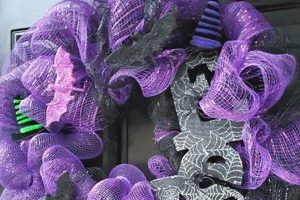The foundation upon which a Christmas tree rests, often constructed at home, is a crucial element for holiday displays. These supports provide stability and prevent tipping, ensuring the tree remains upright throughout the festive season. For instance, a simple wooden structure, a repurposed bucket filled with concrete, or even a creatively assembled metal frame can serve as an effective base.
A well-designed and sturdy tree support offers significant advantages. It enhances safety by reducing the risk of accidents caused by falling trees, particularly important in households with children or pets. Furthermore, it allows for customized height and aesthetic integration within the overall holiday decor. Historically, improvised solutions were common, reflecting a resourceful approach to seasonal celebrations, but modern adaptations prioritize both functionality and visual appeal.
The following sections will explore various methods and materials employed in the creation of stable and visually pleasing tree supports. These projects cater to a range of skill levels and aesthetic preferences, offering options from basic, budget-friendly designs to more elaborate and decorative constructions. Considerations for tree size, weight distribution, and long-term storage will also be addressed.
Essential Guidelines for Homemade Christmas Tree Bases
The construction of a stable and effective Christmas tree base requires careful planning and execution. The following guidelines are intended to ensure both safety and aesthetic appeal in homemade solutions.
Tip 1: Size Appropriately. The base’s dimensions must correlate directly with the tree’s height and weight. A wider and heavier base is essential for taller trees to prevent instability.
Tip 2: Prioritize Stability. Implement a design that distributes weight evenly. A wide stance or a weighted bottom enhances stability significantly, reducing the risk of tipping.
Tip 3: Select Durable Materials. Opt for materials capable of withstanding the tree’s weight and any potential water spillage. Treated wood, metal, or reinforced plastics are viable options.
Tip 4: Incorporate a Water Reservoir. Integrate a system for holding water to maintain tree freshness. A removable container facilitates easy refilling and cleaning.
Tip 5: Camouflage Functionality. Conceal the utilitarian aspects of the base with decorative elements. Burlap, fabric, or painted finishes can seamlessly blend the base with surrounding decor.
Tip 6: Ensure Easy Assembly. Design the base for straightforward assembly and disassembly, facilitating storage and reuse in subsequent years. Modular designs offer enhanced convenience.
Tip 7: Consider Floor Protection. Implement measures to safeguard flooring from scratches or water damage. Felt pads or a protective barrier placed beneath the base are advisable.
Adhering to these guidelines will result in a secure and visually appealing support system for the Christmas tree. Proper planning and material selection are paramount to success.
The subsequent sections will delve into specific design options and construction techniques, providing detailed instructions for creating custom tree supports.
1. Stability
The primary objective in any “stand for christmas tree diy” project is ensuring stability. Without a secure foundation, the entire display is compromised, posing safety risks and diminishing the aesthetic appeal. Stability considerations dictate design choices, material selection, and construction techniques.
- Base Footprint
The area covered by the base directly affects stability. A wider footprint provides a lower center of gravity, reducing the likelihood of tipping. For taller trees, a proportionally wider base is essential to counteract the increased leverage. Examples include using a wider diameter for circular bases or longer legs for tripod designs. Failure to account for this can lead to a top-heavy structure prone to falling.
- Weight Distribution
Even distribution of weight is critical. Off-center loads can compromise the structural integrity of the base and increase the risk of toppling. Strategically placing weights within the base, such as concrete or sandbags, can counteract uneven weight distribution caused by branch asymmetry or decorations. A well-balanced base minimizes stress on individual components and promotes overall stability.
- Material Strength and Rigidity
The materials used must possess sufficient strength and rigidity to support the tree’s weight without deformation. Flexible or weak materials can buckle under load, leading to instability. Steel, reinforced wood, or high-density polymers are often chosen for their load-bearing capabilities. The choice of fasteners and joinery techniques also impacts the overall rigidity of the structure. Substandard materials can result in a precarious and unsafe display.
- Secure Tree Attachment
The method of attaching the tree to the base is paramount for stability. A loose or poorly designed attachment point can allow the tree to shift or even detach from the base. Common attachment methods include using threaded rods, clamping mechanisms, or a combination of both. The attachment must be able to withstand lateral forces caused by wind or accidental bumps. A secure attachment ensures that the tree and base function as a unified, stable unit.
Ultimately, stability considerations are intrinsic to the success of any “stand for christmas tree diy” endeavor. A stable base not only provides a safe and visually pleasing display but also ensures the longevity of the tree by preventing unnecessary stress and movement. Thoughtful planning and meticulous execution are essential for achieving optimal stability in homemade tree supports.
2. Material Selection
The choice of materials is a critical determinant of the success of any undertaking, significantly influencing its durability, aesthetics, and overall functionality. This is especially pertinent in the realm of crafting homemade Christmas tree bases, where the structural integrity and visual appeal are of paramount importance.
- Wood (Dimensional Lumber, Plywood, Reclaimed Wood)
Wood offers versatility and relative ease of workability. Dimensional lumber provides structural strength, while plywood can be used for creating stable platforms. Reclaimed wood introduces a rustic aesthetic, but requires careful inspection for structural soundness. Considerations include wood treatment to prevent rot and insect infestation, particularly if the base will be exposed to moisture from watering the tree.
- Metal (Steel, Aluminum)
Metal provides superior strength and durability compared to wood. Steel offers excellent load-bearing capacity but is susceptible to rust, necessitating protective coatings. Aluminum is lighter and corrosion-resistant but may require specialized welding techniques. Metal bases often lend a modern, industrial aesthetic and are suitable for larger, heavier trees.
- Plastics (PVC, Recycled Plastics)
PVC offers water resistance and ease of shaping, making it suitable for constructing reservoirs or decorative elements. Recycled plastics provide an environmentally conscious option. However, plastics generally have lower load-bearing capacity compared to wood or metal and may be more prone to deformation under weight. UV degradation is also a consideration for outdoor use.
- Concrete
Concrete provides exceptional weight and stability. It can be molded into various shapes and provides a solid foundation, particularly for larger trees. However, concrete is heavy and permanent, making it less suitable for portable or easily stored bases. Proper curing and reinforcement are essential to prevent cracking. Surface treatments can be applied to improve aesthetics and prevent staining.
The selection of appropriate materials is integral to the construction of a stable, aesthetically pleasing, and durable support. Consideration of factors such as load-bearing capacity, environmental resistance, workability, and aesthetic compatibility with the surrounding decor is essential for realizing a successful “stand for christmas tree diy”. The interplay of these factors dictates the lifespan and overall satisfaction derived from the final product.
3. Weight Distribution
Weight distribution is a foundational element in any “stand for christmas tree diy” project, directly influencing the stability and safety of the entire display. The Christmas tree, by nature, presents a complex load profile due to its asymmetrical branch structure and the added weight of decorations. An improperly balanced base will inherently increase the risk of tipping, potentially causing damage to property or, more seriously, injury to individuals.
Effective weight distribution necessitates a base design that counteracts the tree’s inherent imbalances. Consider a scenario where a tree’s branches are significantly denser on one side. Without compensating for this imbalance, the base will be subject to uneven stress, leading to potential instability. To rectify this, strategically placed weights, such as concrete blocks or sandbags, can be incorporated into the base to counterbalance the heavier side of the tree. This approach ensures that the center of gravity remains within the base’s footprint, thereby maximizing stability. A failure to address this, as evidenced by countless instances of toppled trees, underscores the practical significance of understanding and applying weight distribution principles.
In summary, a comprehensive understanding of weight distribution is indispensable for constructing a safe and aesthetically pleasing Christmas tree base. Neglecting this crucial aspect will inevitably compromise the stability of the display, increasing the likelihood of accidents. Proper planning, careful material selection, and strategic implementation of counterweights are essential for mitigating risks and ensuring the successful execution of a “stand for christmas tree diy” project.
4. Water Reservoir
The integration of a water reservoir into a homemade Christmas tree base addresses the fundamental need to maintain the tree’s hydration throughout the holiday season. This feature is not merely an aesthetic consideration, but rather a practical necessity that extends the life of the tree, minimizes needle drop, and reduces fire hazard.
- Hydration Maintenance
The primary function of a water reservoir is to supply the tree with a continuous source of moisture. A freshly cut Christmas tree requires a significant amount of water, often several quarts per day, to prevent dehydration. Failure to provide adequate water leads to needle desiccation and premature shedding, diminishing the tree’s aesthetic appeal and increasing flammability. Regular replenishment of the reservoir is, therefore, essential.
- Fire Hazard Reduction
A well-hydrated Christmas tree is significantly less flammable than a dry one. Dry needles act as kindling, rapidly igniting and accelerating the spread of fire. Maintaining adequate water levels in the reservoir mitigates this risk, providing a degree of fire resistance. This is particularly crucial in homes with open flames, such as fireplaces or candles, or where electrical decorations are used.
- Structural Support Enhancement
A water-filled reservoir contributes to the overall stability of the base by adding weight and lowering the center of gravity. This is particularly beneficial for taller trees or those with a wide branch spread. The added weight helps to prevent tipping and provides a more secure foundation for the tree, enhancing its safety and longevity.
- Design Integration
The water reservoir can be seamlessly integrated into the base design, both functionally and aesthetically. It can be concealed within the base structure or incorporated as a visible element, such as a decorative bucket or container. Accessibility for refilling is a crucial design consideration. A well-designed reservoir allows for easy replenishment without disturbing the tree or its decorations.
In conclusion, the incorporation of a functional water reservoir into a homemade Christmas tree base is a practical and essential element that contributes to the tree’s longevity, safety, and overall aesthetic appeal. Its benefits extend beyond mere convenience, playing a crucial role in fire prevention and ensuring a vibrant holiday display.
5. Aesthetic Integration
Aesthetic integration, in the context of a self-constructed Christmas tree support, refers to the harmonious blending of the base with the surrounding decor. While functionality and stability are paramount, the visual impact of the tree support significantly contributes to the overall ambiance of the holiday display. The underlying principle is that the base should complement, rather than detract from, the tree and its ornaments. For example, a rustic wooden base may suit a tree adorned with natural elements and vintage ornaments, while a sleek metal design may better accompany a modern, minimalist aesthetic. Disregard for aesthetic integration can result in a visually discordant display, undermining the intended festive atmosphere.
The selection of materials, colors, and textures plays a crucial role in achieving effective aesthetic integration. Employing colors that harmonize with the existing color palette of the room, or utilizing natural materials that complement the tree itself, can create a cohesive and visually pleasing effect. Furthermore, concealing the functional components of the base, such as the water reservoir or support structure, behind decorative elements can enhance its aesthetic appeal. Consider a base cloaked in burlap and adorned with pinecones, or one painted with festive motifs. Conversely, a poorly executed integration, such as a brightly colored plastic base clashing with a traditional tree, diminishes the overall aesthetic impact.
Achieving successful aesthetic integration in “stand for christmas tree diy” projects presents a balancing act between functionality and visual appeal. While stability and practicality remain primary concerns, the visual contribution of the base to the overall holiday aesthetic cannot be overlooked. Careful consideration of material selection, color palettes, and decorative elements is essential for creating a cohesive and visually harmonious display, enhancing the festive ambiance of the space and contributing to the overall enjoyment of the holiday season.
6. Ease of Assembly
In the context of constructing a Christmas tree base, the ease with which the structure can be assembled and disassembled is a key factor influencing user satisfaction and practicality. Complexity in design or construction processes can deter individuals from pursuing a do-it-yourself approach, favoring pre-fabricated alternatives.
- Modular Design Principles
The implementation of modular design principles directly impacts the simplicity of assembly. Modular designs involve breaking down the base into distinct, easily connected components. This approach reduces the need for intricate joinery or specialized tools. An example would be a base composed of pre-cut wooden legs that attach to a central hub using bolts. Complicated designs can lead to misalignments or structural weaknesses, ultimately undermining the stability of the base.
- Tool Requirements Minimization
Excessive reliance on specialized tools can present a barrier to assembly for many individuals. Designs that minimize tool requirements or utilize commonly available tools, such as screwdrivers or wrenches, enhance user accessibility. A base that can be assembled entirely with hand tools is generally more desirable than one requiring power tools or specialized equipment. This is due to the reduction of complexity.
- Clear Instructional Documentation
Even a well-designed base can be rendered unusable if the assembly instructions are unclear or incomplete. Comprehensive and easily understandable documentation is essential for guiding users through the assembly process. This documentation should include detailed diagrams, step-by-step instructions, and troubleshooting tips. Ambiguous or poorly illustrated instructions can lead to errors and frustration, negating the benefits of an otherwise well-designed base.
- Component Weight and Handling
The weight and ease of handling individual components influence the physical demands of assembly. Overly heavy or unwieldy components can pose a challenge, particularly for individuals with limited strength or mobility. Lighter materials and ergonomically designed components enhance the ease of handling, reducing the risk of strain or injury during assembly. A lighter base also offers the benefit of easy storage.
Ultimately, the ease of assembly represents a critical consideration in “stand for christmas tree diy”. A base that is simple to assemble, requiring minimal tools and clear instructions, is more likely to be adopted and successfully implemented. Prioritizing these factors enhances the user experience and contributes to the overall satisfaction derived from creating a homemade Christmas tree base.
7. Floor Protection
The integration of floor protection measures within a “stand for christmas tree diy” project is a crucial consideration often overlooked, yet vital for preserving the integrity of flooring surfaces. Moisture from tree watering and potential scratches from the base itself pose significant risks to various floor types, including hardwood, laminate, and carpeting. For example, prolonged water exposure can cause warping and staining on hardwood floors, necessitating costly repairs. Similarly, the abrasive nature of some base materials, such as unfinished metal or rough wood, can easily damage delicate surfaces. The absence of adequate floor protection directly contributes to avoidable expenses and diminishes the long-term value of the home.
Effective floor protection strategies range from simple solutions to more elaborate implementations. A basic approach involves placing a waterproof mat or tray beneath the tree base to contain spills and prevent water damage. For bases constructed from materials known to scratch, the application of felt pads or rubber bumpers to the underside is advisable. More sophisticated solutions may include designing the base with an integrated protective layer, such as a recessed platform lined with waterproof material. Real-world applications demonstrate that diligent floor protection significantly reduces the incidence of water damage and scratches, preserving the aesthetic appeal and structural integrity of flooring surfaces.
In conclusion, the incorporation of floor protection is an indispensable component of any “stand for christmas tree diy” initiative. Neglecting this aspect can lead to costly repairs and diminished home value. Implementing proactive measures, ranging from simple mats to integrated protective designs, effectively safeguards flooring surfaces from water damage and scratches. A comprehensive approach to floor protection reflects a commitment to both the functionality and longevity of the Christmas tree display, ensuring a positive and sustainable outcome.
Frequently Asked Questions
The following section addresses common inquiries regarding the construction of homemade Christmas tree supports. The aim is to provide clarity and guidance for individuals undertaking this project.
Question 1: What is the minimum base size required for a seven-foot Christmas tree?
A seven-foot tree typically requires a base with a minimum diameter of 24 inches. This dimension provides sufficient stability to prevent tipping, particularly when adorned with ornaments.
Question 2: What type of wood is most suitable for constructing a durable tree base?
Pressure-treated lumber or hardwoods such as oak or maple offer superior resistance to moisture and structural integrity. These materials are capable of withstanding the weight of the tree and potential water spillage.
Question 3: How can the risk of water damage to flooring be minimized when using a homemade base?
The incorporation of a waterproof tray or the application of a sealant to the base’s underside provides a barrier against water leakage. Additionally, elevating the base slightly allows for air circulation and reduces moisture accumulation.
Question 4: What is the recommended method for attaching the tree trunk to the base?
Utilizing a system of threaded rods and adjustable clamps provides a secure and adaptable method for securing the trunk. This allows for minor adjustments to ensure the tree stands upright.
Question 5: How can the aesthetic appeal of a DIY tree base be enhanced?
Wrapping the base with burlap, fabric, or decorative paper allows for customization and seamless integration with the surrounding decor. Painting or staining the wood can also enhance its visual appeal.
Question 6: What safety precautions should be observed when constructing a Christmas tree base?
Appropriate safety measures include wearing protective eyewear when cutting or drilling materials, using caution when handling power tools, and ensuring the base is placed on a stable and level surface.
The information provided aims to address common concerns and promote safe and effective construction practices.
The subsequent section will explore design variations and advanced techniques for creating custom tree supports.
Conclusion
The preceding examination of stand for christmas tree diy encompasses critical aspects ranging from stability and material selection to aesthetic integration and safety considerations. Successful implementation necessitates a thorough understanding of these elements, ensuring both a visually appealing and structurally sound support system. The inherent challenges involved in constructing a reliable base underscore the importance of meticulous planning and execution.
Individuals embarking on such projects are advised to prioritize structural integrity and safety above all else. While aesthetic customization offers considerable creative freedom, a compromised foundation jeopardizes the entire display. Thoughtful application of the principles outlined herein will yield a Christmas tree display that is not only visually impressive but also safe and enduring.







